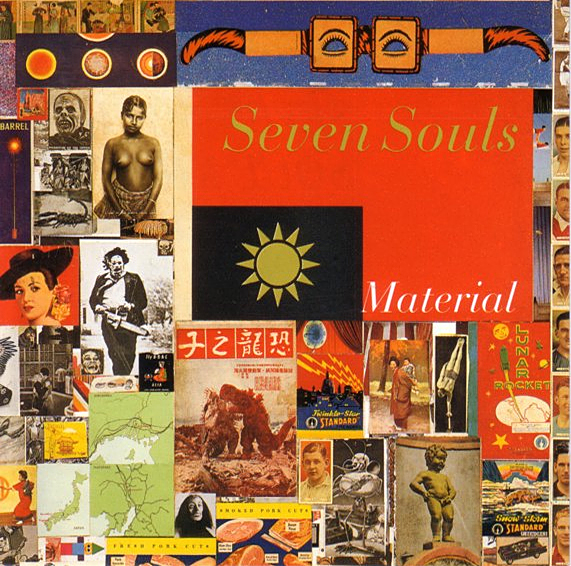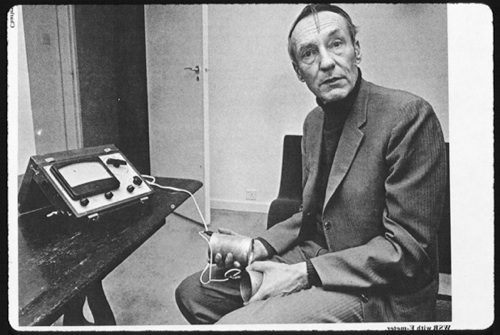
Related to some earlier posts on cut-ups and William Burroughs, I received a very high quality art book published by The New Museum called Brion Gysin - Dream Machine. Brion Gysin is the person who introduced Burroughs to the Cut-Up technique. They carried on a very productive artistic collaboration for a number of years experimenting with all kinds of artistic media and magic.
The book is the companion volume to a Brion Gysin show currently up at the New Museum in New York:
The New Museum will present “Brion Gysin: Dream Machine,” the first US retrospective of the work of the painter, performer, poet, and writer Brion Gysin (born 1916, Taplow, UK–died 1986, Paris). Working simultaneously in a variety of mediums, Gysin was an irrepressible inventor, serial collaborator, and subversive spirit whose considerable innovations continue to influence musicians and writers, as well as visual and new media artists today. The exhibition will include over 300 drawings, books, paintings, photo-collages, films, slide projections, and sound works, as well as an original Dreamachine—a kinetic light sculpture that utilizes the flicker effect to induce visions when experienced with closed eyes.
The show runs until October 3rd and I'm told that it's "really good." Bill Laswell and John Zorn played the opening.
I remember first experimenting with the flicker effect when I was about 12. It wasn't a Dreamachine, though. My technically talented friend Steve, same age as I, made a device using a piece of cardboard that had a hole cut out placed on an old turntable with a light shining through it from the back. He had also figured out how to vary the speed of the turntable, and along with trying different ways of placing the holes in the cardboard, had learned how to produce varying frequencies of light emission. It was quite effective.
Steve was also the first person to introduce me to the powerful mood changing effects of audio manipulation. We recorded the Beatles Revolution #9 onto a cassette tape. Steve was able to take the cassette apart and flip the spindles so that it would play backwards when reassembled. The effect was incredibly spooky such that I felt brought into another world or at least shown the entrance. A strange space that had different rules of physics than I was used to. A little unnerving, to say the least.
John Lennon and Yoko Ono, the creators of this cut-up art montage sound machine, apparently had deliberately recorded sounds and voices backwards. Actually the whole thing sounds just as coherent (or incoherent depending on how the brain receives it) backwards as it does forwards. At one point a male voice is clearly heard to say:
Are we not all dead? The answer is yes, yes.
And the voice that repeats Number 9, Number 9 over and over, backwards sounds like:
Turn me on, dead man. Turn me on, dead man. said quickly with an English accent.
Some people related it to the whole 'Paul is dead' urban legend which was still in the air. I don't think it had anything to do with that, at all.
One of the artists in the Gysin retrospective, Sue De Beer recounts in the book her experiences around the work she did on a film called The Quickening which featured a Dreamachine. She closes with an excellent description of what it feels like in a bardo space ... the land of the dead ... the place of in-betweenness. This is what she wrote:
The following calligraphic Cut-Up, created by Gysin, was used by Burroughs to end his novel Nova Express (1964):
to say good silence by -- good to say by silence-- by silence to say good-good & good-bye."
To me, this phrase evokes the liminal space between dream and waking, death and life, that, ultimately, I was trying to map in my work of 2005-2007-- the space behind your eyes as you fall asleep, or as you wake, that can contain fear and death, or birth and life."
Not remembering exactly what 'liminal" means, I looked it up. This is the definition from Merriam Websters:
Main Entry: lim·i·nal
Pronunciation: \ˈli-mə-nəl\
Function: adjective
Etymology: Latin limin-, limen threshold
Date: 1884
1 : of or relating to a sensory threshold 2 : barely perceptible
3 : of, relating to, or being an intermediate state, phase, or condition : in-between, transitional
It's interesting that Sue De Beer says that she 'was trying to map' that space. She's not the only one. In her account she talks about building and using a Dreamachine then writing down her visions.
There used to be a Dreamachine in the control room area of Laswell's Greenpoint Recording Studio. I don't know what happened to it after the studio moved to Orange Music. Greenpoint also had an Eye of Horus design set on top of a small bell. Bill gave it to me at the time of the studio's transition. It's still in my possession.
I feel a particular connection to Brion Gysin because it was Gysin who first brought The Master Musicians of Jajouka to the attention of the world. He had chanced upon them in the early '50's while travelling around Morocco with Paul Bowles. Their music moved him so much that he opened a restaurant in Tangier called The Thousand and One Nights just so they would have a place to play. He said it was music that he wanted to hear every day for the rest of his life.
A highlight of my sound career was recording the Master Musicians of Jajouka in Jajouka. I would say their music extensively surveys and maps liminal spaces. More on that story another time.










